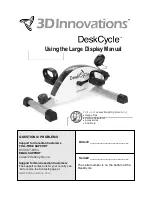
10
Adjust Flywheel/Chain Tension
Over time and after substantial use, the chain on the CycleOps Phantom Series indoor cycle will stretch. Adjusting the
tension/alignment is a difficult task and improper adjustment can lead to premature chain/cog wear. It is recommended
this task be done with assistance from an authorized indoor cycle dealer. The chain tension has been adjusted properly
when there is little or no play felt when the pedals are rocked back and forth.
NOTE: Be sure to make small incremental adjustments to the tensioning hardware on both sides of the flywheel. Only
adjusting one side will lead to improper flywheel alignment and unwanted drive train wear and/or noise.
CAUTION: Improper chain adjustment will cause premature wear and may void the warranty.
CAUTION: NEVER put hands into or near the drive train while it is in motion!
1. Using a 4mm Allen wrench, remove
the three chain guard bolts.
3. Use a 17mm cone wrench to hold
the axle locking nuts in place. Do not
turn the wrench, it is only used as a
stabilizer. With the other hand, use a
15mm box wrench to loosen the flange
nuts on the axle. Repeat this process
on each side of the flywheel.
4. Using a 10mm box wrench, adjust
the tensioning hardware until the
proper chain tension is achieved evenly
on both sides.
5. Pull chain down (midway between
chain
ring and gear) to measure vertical
travel. Vertical travel should be approxi-
mately
1/4” when the chain has been properly
adjusted. Tighten flange nuts to 75 in-
lbs. Do not overtighten.
10 mm tensioning
hardware
Flange Nut
Axle Lock
Nut
2. Pull chain down (midway between
chain ring and gear) to measure verti-
cal travel. Vertical travel should be
approximately 1/4”. Vertical travel with
significantly more or less than 1/4”
should be adjusted.
Vertical
Travel
Vertical
Travel

































